Advantages and Disadvantages of BT Cotton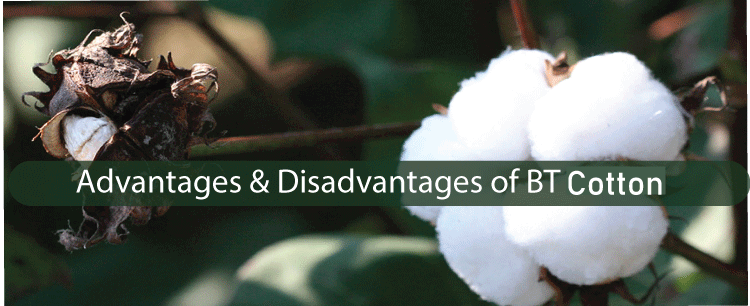
CottonWe all are familiar with the word "cotton" in different forms. We fetch cotton from the cotton plant daily (cotton balls, cloth, and materials made from cotton). Cotton is the product or part of a white cotton plant that grows the fluffy cotton fibers -the boll (a seedpod of the cotton plant that grows to around the size of a golf ball). Firstly the cotton plant flower grows then the ball starts to grow. The ball has 7-8 seeds, with cotton fibers that look like seed hairs. Cotton is breathable, natural fiber, comfortable, machine washable, durable, soft, no static, and easy to color/ print. Cotton is one of the major producing crops in the world, as cotton has played a vital role in the production of cloth and furniture since ancient times. 60% of the fiber used in the textile industry came from cotton cropping and millions of tons of quality animal feed & cooking oil. We have been using cotton for more than 7000 years for many purposes, and it was the first crop used worldwide commercially or non-commercially. Cotton originated in America, Africa, Egypt, and India. Cotton is produced on vast agricultural land, but the cultivation is affected by insects, pests, and other harmful chemicals. Due to this, farmers and industrialists have to bear the tremendous loss, but cotton is necessary daily. Therefore to deal with this, scientists discovered BT (bacterium bacillus thuringiensis) in 1901 by investigating the cause of sotto disease that was killing a large population of silkworms by biologist Shigetane Ishiwatari. Genetic engineering has given a new way to modern agricultural biotechnology. Through genetic engineering, we can achieve such modification of plant features that is impossible through regular plant breeding. Three types of GE crops combine the HT and Bt traits: HT (herbicide tolerant), Bt (insect-resistant), or "stacked" cultivators. HT crops are an alternative for weed control with one or more herbicides that target weeds without harming crops. In India, there are two types of BT crops i.e. 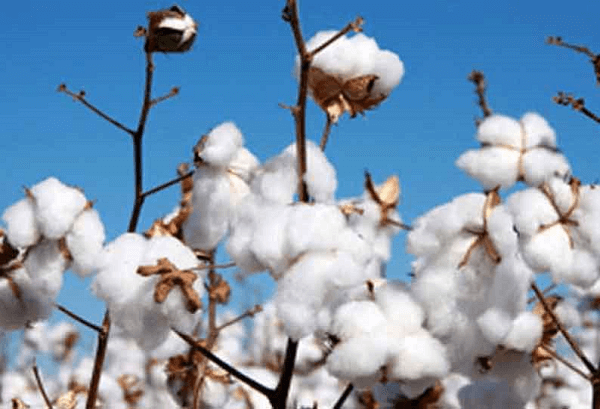
BT brinjal was produced in 2008 from gene technology (same as BT cotton). It was first developed by hybrid Seed Company named Mahyco, Maharashtra, and the commercialization of the brinjal was approved by the Indian government in 2009. The product was resistant to FSB (fruit and shoot borer) that prevents 95% of the fruits and produces a crop loss of up to 70%. BT cotton: It is a type of plant cotton plant that came into existence as a genetically modified pest-resistant plant cotton variety. To reduce the use of pesticides and chemicals, these genetically modified (GMO) cotton plants are developed companies. BT cotton does not need pesticides and insecticides as they are replicants for insects and pests. BT refers to the "bacillus thuringiensis," a type of bacteria that can produce more than 200 BT toxins, dangerous to insects. BT cotton is prepared by coding BT toxin in the genes of cotton as a transgene and creating a natural pesticide in its tissue. BT cotton is a genetically modified crop that can produce toxic proteins for specific insects. It is a pest-resistant cotton variety with an insecticide to combat bollworm infection. About two decades ago, BT cotton was introduced to India to minimize the use of insecticides by farmers. Monsanto and Mahyco seed Hybrid Company introduced this in 2002 through a joint venture. BT produces crystal-like proteins that can kill specific groups of insects and other organisms. In 2011, India had the most significant BT and GM cotton quantity in 10.6 million hectares. BT cotton can kill its major pest (cotton bollworm). In History: After the invention of Bt cotton, it was approved by the United States in 1993 for filed trials. In 1995, it was approved for commercial use in the United States, and the Chinese government approved it in 1997. In India, it was introduced in 2002, with a joint venture between Monsanto and Mahyco seed hybrid company. In 2011: The first most significant producer of GM cotton crops in the area was India, with 10.6 hectares. In the U.S., the production of GM crops was about 4.0 million hectares (second largest size), followed by China (3.9 million hectares) and Pakistan (2.6 million hectares). 2014: the United States has grown 96% of the genetically modified cotton, and India does 95% of cotton. Hence India, the United States, and China are leading producers of BT cotton worldwide. 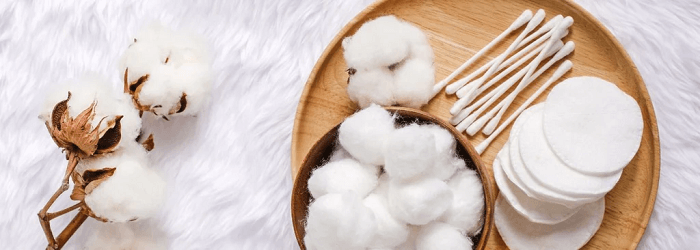
Difference: The main difference between cotton and BT cotton is that it is a genetically modified type of cotton that replicates to insecticide and pesticide without external chemicals in the cotton field, but ordinary cotton can't protect itself. Cry toxins and VIP toxins are produced under BT cotton varieties targeting specific caterpillar pests (beet armyworm, tobacco budworm, Helicoverpa, Spodoptera exigua, Heliothis virescens, and cotton bollworm). Advantages of BT cotton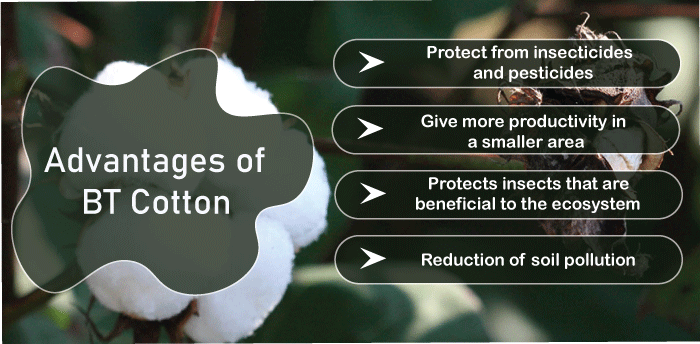
a) Protect from insecticides and pesticides. The Bt cotton plant produces an insecticide to combat bollworms. This plant has a bollworm insecticide. A cry gene of bacillus thuringiensis introduced in the Bt cotton plant produces a crystalline Bt. The component that activates after thing the alkaline intestine of a pest after being consumed by them. It makes holes in the intestine that destroy them. b) Give more productivity in a smaller area. India is one of the leading producers of cotton worldwide. Hence cotton is considered an important commercial crop that accounts for around 25% of global production. About 6 million farmers and 40-50 million people use cotton production to sustain their livelihood. As BT cotton is disease free, that leads to more cotton productivity in a small area of land, which leads to a 50% gain in profit in cotton small and large holders. Due to pest reduction, there is a 24% increase in cotton yield per acre, creating significant and sustainable benefits. It contributes a positive impact on the economic and social development of India. c) Protects insects that are beneficial to the ecosystem Bt cotton plant is genetically altered to produce proteins harmful to certain insects and pests but results in the beneficial environment, human health, and economic benefits. It is designed to target insects and pests by controlling lepidopteran (moth) larvae (budworms and bollworms). It can also control lepidopteran larvae (corn borers) and coleopterans (corn rootworm beetles). It naturally contains the pests that benefit the ecosystem (keeping soil, water, and air pollution free). d) Reduction of soil pollution Bt cotton is a self-insecticide and pesticide-resistant and reduces the use of synthetic pesticides on the cotton crop, helping control soil pollution. Disadvantages of BT cotton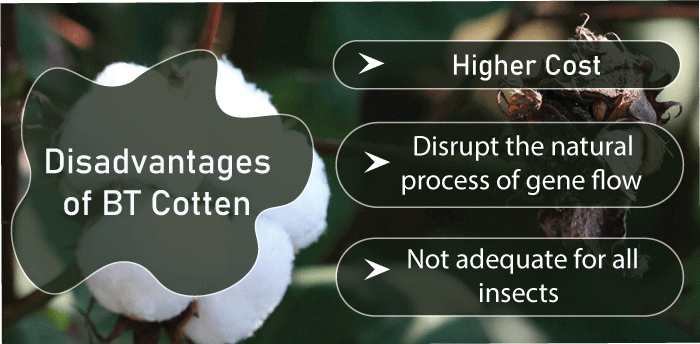
a) Higher cost Compared to standard cotton production costs, Bt cotton production is costlier. The seed can cost between 700 to 2000 rupees, i.e., three to eight times more than the cost of a conventional source. b) Disrupt the natural process of gene flow. As bt cotton is a genetically modified crop that contains one or more foreign genes derived from soil-dwelling bacterium (bacillus thuringiensis), it can't be produced naturally and disrupt the process of gene flow. c) Not adequate for all insects Bt cotton is toxic to pollinating insects and ineffective against pests such as plants, bugs, stink bugs, whitefly, and aphids. Conclusion:In the cotton industry, it's one type of BT cotton came as a boom that made a tremendous rise in yield production manageability, employment, and reduction in cost. In starting, this crop was only introduced to the U.S., then to Brazil, South Africa, Argentina, Australia, and China, and slowly covered worldwide. This crop impacts cotton profit, cotton yield, and household living standards. It has caused sizeable socioeconomic benefits, especially for smallholder farm households in India. Cotton yields and profits increased by 24% and 50%. With the increase in profit, the household living standard increased by 18% among BT adopters. This profit will increase due to advancements in biotechnology and gene therapy. Bt cotton's advantages and disadvantages clarify its applicability all over the world. |
 For Videos Join Our Youtube Channel: Join Now
For Videos Join Our Youtube Channel: Join Now
Feedback
- Send your Feedback to [email protected]
Help Others, Please Share










